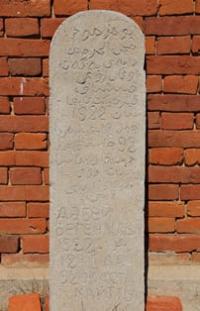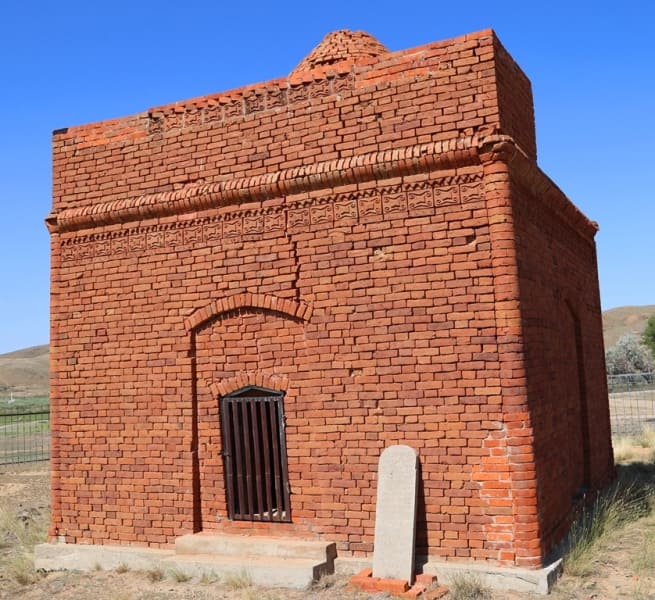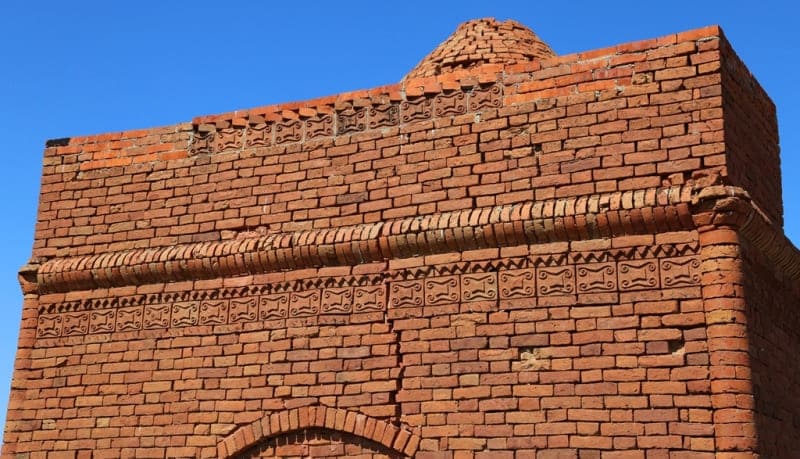Вы здесь
Zherapai Maikin Mausoleum.

Outstanding architectural monuments of Ulytau region.
"The custom of the Kazakh people is this: whenever they are raided, all the clans that make up one ulus and are stationed in one area gather with weapons and equipment to protect their families and property and use the cutting swords of zeal and ardor. Each detachment, consisting of several families, stands in front of their families and property. If the Kazakh army unites in one place with the intention of repelling the enemy [and] raises the banner of resistance, then it is very difficult to repel it."
Historical and ethical work "Mikhman-name-i Bukhara" "Notes of a Bukhara guest". 1509.
History of ancient monuments of Ulytau.
Zherapai-Maikin Mausoleum is located at an altitude of 345 meters above sea level, on outskirts, in northern part of village of Korgasyn, 156 meters from left bank of Kara-Turgay River, 69 kilometers northwest of village of Ulytau in Ulytau district of region of same name.
In size, this is a small building, built of dark red burnt brick on clay mortar. In composition, it belongs to the central-domed structures with a single-chamber room. The mausoleum was erected on a shallow foundation, made of flagstone on clay mortar.
Its base is a cube, on which a conical dome rises. On the front facade, oriented to the southwest side, a small parapet (imitation of a peshtak) with a height of 1.09 meters was erected. The height of the cube from the ground to the edge of the cornice is 4.20 meters, the height of the conical dome is 2.90, and the total height of the mausoleum is 7.10 meters.
For the decorative and architectural design of the facade, shallow niches on the side and back walls, half-columns made of patterned bricks at the four corners, a frieze of various ornamented terracotta tiles (without glaze) and an oval cornice were used.
The wall niches, slightly narrowing towards the top, are covered with sluggish bow-shaped arches. The ornament of the frieze tiles is very simple - in the form of curls placed in pairs opposite each other, like "koshkar-muyuiz", drawn in relief.
Initially, before firing, their background, apparently, was painted in a greenish-red color, which subsequently faded, as can be judged by the remaining traces. The design of the cornice is completely unique, not found anywhere else. Above the frieze, one row of bricks is laid "on the edge", a shallow profile in the form of a comb (zigzag) is applied to it, then there is one row of bricks in a "spoon", and, finally, the cornice is completed from above with two halves of a patterned brick, forming a half-shaft in section.
In the ordinary masonry of the parapet on the front facade, a small belt is brought out, designed as a frieze, which slightly enlivens its plane. In plan, the mausoleum, both in its outer outline and in its inner outline, is a square with sides equal to 5.68 x 5.60 and, accordingly, 3.46 x 3.52 meters.
The arches are weak, their proportions are unsuccessful. Behind the arches there are sails, decorated with brickwork in the form of overhanging rows, which end with an arch shelyga on the 9th row. The upper belt of the walls is made of zigzag brickwork, and a conical dome rests on it.
To climb to the domed platform, in the right corner from the entrance, there is a small ladder-manhole about 38 cm wide, leading up. Passage through it is extremely difficult. The brick floor in the mausoleum, laid in one row "flat", does not have structures in the form of a sagana indicating the burial place of the deceased.
According to the residents of the village of Ulu-Tau, it was built in the nineties of the XIX century by the bai Zherapai-Maikin.
Geographic coordinates of Zherapai-Maikin mausoleum: N49 ° 13'03 E66 ° 39'26.



Authority:
G.G. Gerasimov. "Architectural monuments of the valley of the Kara-Kengir river in Central Kazakhstan". Publishing house of the Academy of Sciences of the Kazakh SSR. Alma-Ata. 1957.
Alexander Petrov.
Photos by:
Alexander Petrov.







